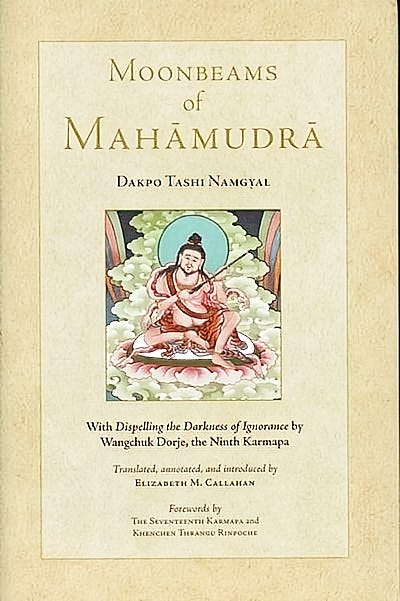The Moonlight of Mahamudra Do not entertain any ambitions about what should or should not be cultivated by meditating. Do not be happy when calm or unhappy when thoughts move; rather, relax your attention loosely. Do not inhibit one thing while promoting another. Do not make adjustments. Leave your attention as it naturally is--relaxed and free. From within this state, maintain a presence of mind that is simply not distracted. Do not fidget; be expansive and clear. Train in being open and vividly present. While training in this way, when an obtrusive thought intrudes, you need neither begin to block it nor pursue it. Rather, maintain a steady and unwavering presence of mind. --Dakpo Tashi Namgtal
The passage above is an instruction on Mahamudra meditation from Dakpo Tashi Namgtal, a 16th Century scholar in the Kagyu and Sakya schools of Vajrayana Buddhism.
A friend read that passage today in the sangha I attend via Zoom every morning, and it fits the subject I want to address in answer to a question posed by another friend who reads all of my posts but has little other understanding of Buddhism. She suggested there’s so much for her to absorb in each of my posts that maybe I should spread them out—leave more time to contemplate and absorb each one.
The first answer is a practical one: She’s such a good friend and avid reader that she reads every one of my posts, which I’ve written and published at a rate averaging one every 36 hours. I recognize, though, despite what my egoic mind would like me to believe, most subscribers don’t read every post (but consider yourself thanked if you do).
The second answer is a more significant one. The Vajrayana Buddhism I practice, in Dzogchen as well as Mahamudra traditions, calls on practitioners to let our mind rest in its innate nonconceptual state. We’re conditioned to think in words, and as soon as we do we’re distorting reality. Of course, we need words to help guide us, but the goal in Vajrayana Buddhism is to reach experientially the wise, pure, and compassionate mind without verbal elaboration.
Repeating a quote from Father Thomas Keating that I’ve used before:
Silence is the first language of God; all else is a poor translation.
We’re so conditioned to our bada-bada-yada-yada conceptual mind that learning to rest in awareness takes time and practice.
How to Meditate by Resting in Awareness
I chose this photo to set the tone. Meditation comes in many shapes and sizes, including while sitting on a park bench, reading a book, and drinking a cup of coffee. It can be done with the legs crossed and the head back. It can be done in a few seconds or for a lot longer. The key for me is awareness, which I’ll discuss mor…
That brings me back to the Moonlight of Mahamudra instruction that began this post. Remember that meditations are practice periods for the rest of our days. Not everyone is temperamentally equipped to spend extended periods sitting still in silent meditation, but all of us can spend time in awareness. The more time we spend in awareness, the closer we get to our innate Buddha Nature.
If we think of Namgyal’s advice as a way to absorb Vajrayana teachings, we might replace the word (and the concept of) “meditating” in the first line, replacing it with “listening and reading.” That way, we might absorb more without being distracted by the need to analyze the words by dragging them through our bada-bada-yada-yada machine. We might absorb more of the essence.
When I rest in awareness to read or listen, the words get absorbed into my conceptual mind as they are, without analysis, and the essence flows to my innate nonceptual mind. I can let any possible arguments and doubts surface later. Maybe those doubts are healthy and need to be addressed, but there’s no hurry. They can wait.
No only did my sangha mate choose a reading that fits today’s post, but Yongey Mingyur Rinpoche chose a subject for his monthly teaching that also addresses the topic if one thinks of meditation as something one can do while reading and listening to teachings. That part starts about halfway through the nine-minute video, but it’s all well worth watching and listening to—especially if you do from a state of relaxed but alert awareness.
From the Pure Land is read by subscribers in 23 US states and eight countries.
If you have found this blog post helpful, whatever your religious path, please share it with your friends.
All subscribers, free or paid, get the same From the Pure Land content. Paying for your subscription is a way of supporting my work. From now until the U.S. Labor Day on September 2, paid subscriptions are discounted by 40% for the first year. So they’re $3 a month or $30 a year. Click here or on the button below to make sure you get the reduced rate. After a year, if you don’t end your subscription, it will renew at the $5 or $50 rate. But you get the reduced rate for your first year only if you subscribe by September 2.
Whatever you decide, you’re supporting my work simply by reading it.




🙏🙏